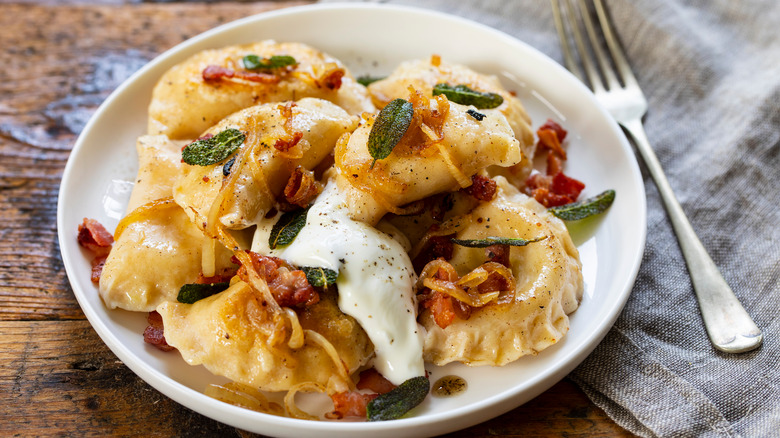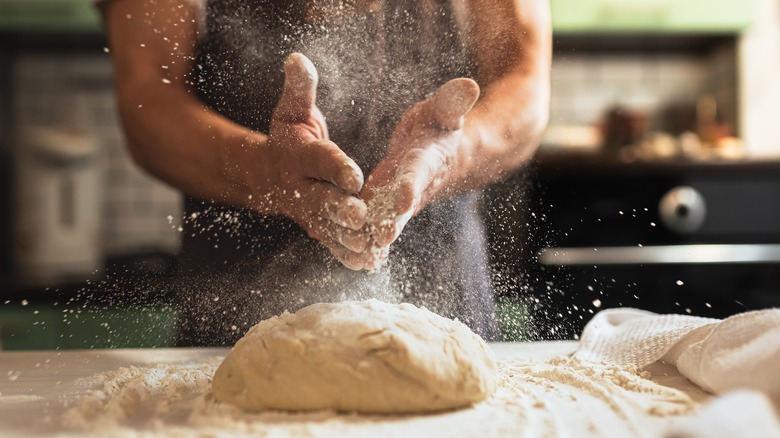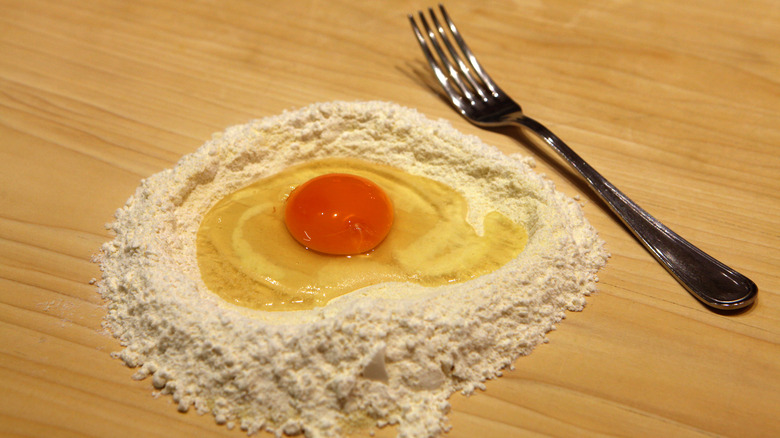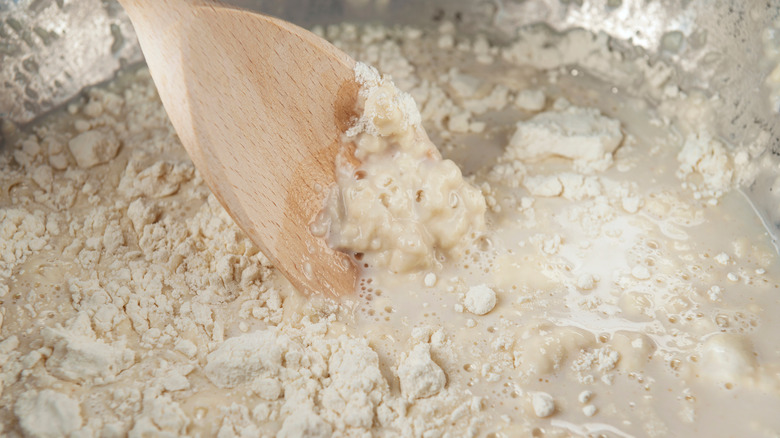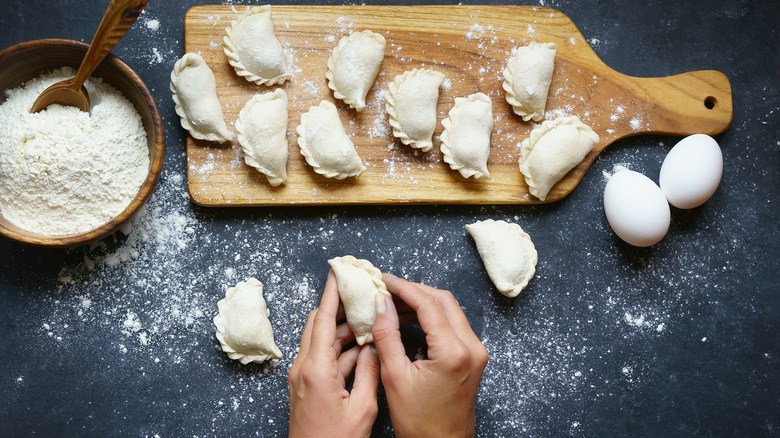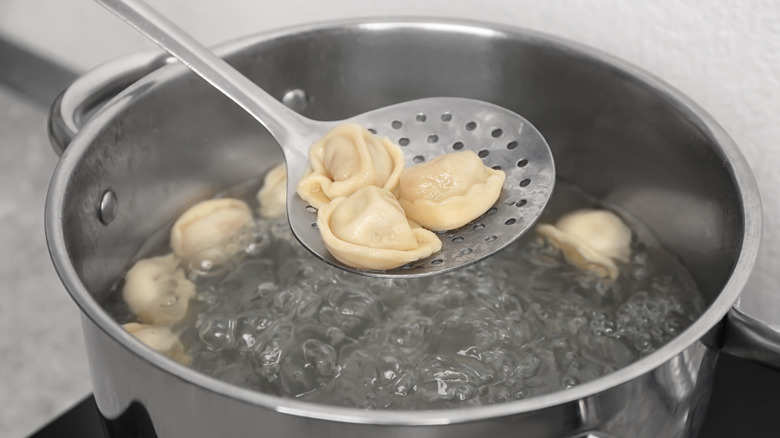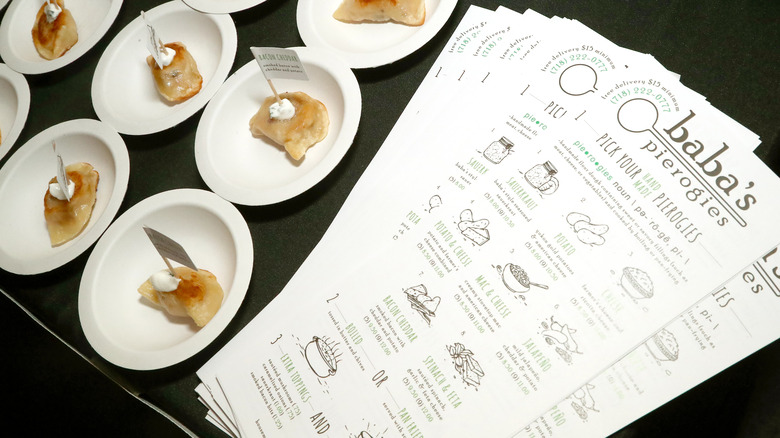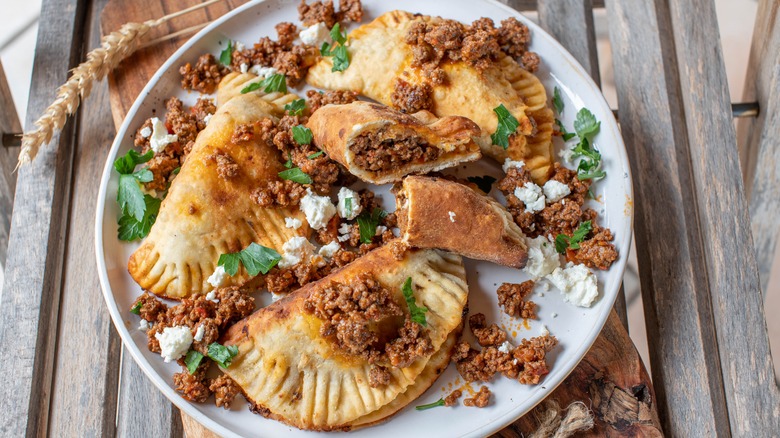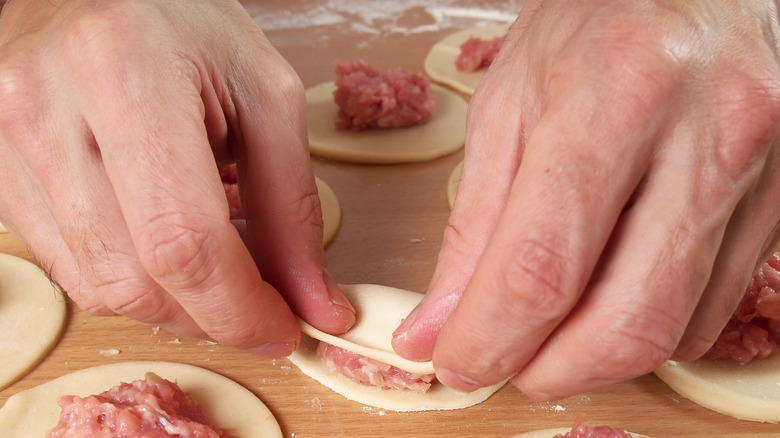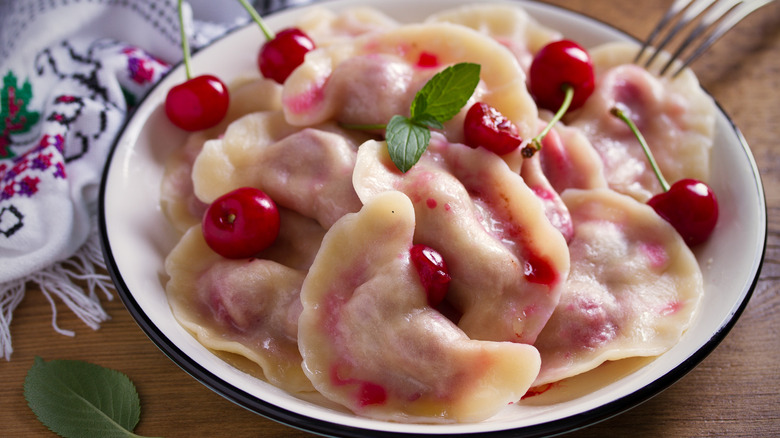The 10 Biggest Mistakes Everyone Makes When Cooking Pierogies
Being the national dish of Poland and having its own patron saint, pierogi deserves nothing but flawless preparation. Unfortunately, many people don't give pierogi recipes a second thought, especially in parts of the United States where the stuffed dumpling isn't a traditional meal.
An untold truth about pierogi is that it is very popular in areas with large communities of Polish immigrants located in the Midwest and around the Great Lakes. According to the supermarket chain Giant Eagle, more than over 68% of US pierogi consumption each year happens in an area stretching from New York State west to Indiana and then north to Illinois — a region that has been called "the pierogi pocket."
While the true origins of pierogi are unknown, legend has it St. Hyacinth of Poland brought them to starving villagers in the 13th century. Some claim this legend is evidence that Hyacinth invented pierogi, and the story is so ingrained in Polish culture, a common Polish exclamation is "Swiety Jacek z pierogami!" which means, "St. Hyacinth and his pierogi!"
With such a storied history in both Poland and United States, pierogi deserve your respect. The next time you are looking to make pierogi, we urge you to avoid following these common mistakes.
Overworking the dough
One of the biggest mistakes people make with pierogi is treating the dough as if it were pasta dough and kneading it to death. When you overwork pierogi dough, it becomes too elastic and resists holding its shape, shrinking back when stretched (via A Dumpling Thing). In a video with Munchies, food author Emily Fedner says soft and malleable is the ideal texture to go for when making dough for pierogi-style dumplings.
To make pierogi dough, start by mixing dry ingredients, which are typically just flour and a bit of salt. Then combine the wet ingredients; usually water or milk and one or more eggs depending on the desired yield. Add the wet ingredients to the dry ingredients and incorporate them to create a shaggy dough. Add flour if the dough is too sticky to work with, or add liquid if it is crumbly. Knead the dough until it feels capable of being rolled out into a sheet and it has a slight elasticity. Allow the dough to rest for at least 15 minutes. Roll the dough into a sheet that is just thick enough to hold the filling without bursting open. Cut the dough into discs using a biscuit cutter or tumbler glass, add the filling, fold in half, and pinch the edges together to form a closed pocket.
Using too much egg
Although the earliest pierogi dough recipes did not include any egg, most modern recipes do. Egg provides protein and fats that help dough maintain its structure but including too much egg can lead to a tough dough (via Tasting Poland). If you stick with a tough, eggy dough, it will cook up hard and have an off taste (via DW News).
If you suspect that you may have incorporated too much egg into your dough, you can still fix it. Add a few drops of milk or water at a time until the dough becomes more pliable. If your dough becomes too wet, add in a bit of flour.
If you feel like your pierogi dough needs a bit more structure, it's very difficult to add less than a whole egg. Unfortunately, eggs come pre-portioned, and this is why eggs can complicate scaling down recipes. Because cooking is more forgiving than baking, it is perfectly fine to crack an egg into a bowl, whisk it, and measure out half an egg (or a quarter) as best you can.
Only sticking with water to make the dough
Many people use water to bind together their pierogi dough, including the self-proclaimed Polish Chef on YouTube, but water doesn't bring much in terms of flavor. If you see pierogi dough as merely a delivery system for delicious fillings, that's fine. But if you want your dough to be more than a placeholder, you should use consider using milk to make your pierogi, as Martha Stewart does.
It's important to note there is a bit of a trade-off when it comes to substituting milk for water. Milk adds richness to the dough, but the fat and proteins in milk can make the dough somewhat sticky. Using water, on the other hand, results in a pliable dough that is easy to work with (via A Dumpling Thing). Milk also brings added sweetness in the form of lactose, and as a result, is maybe a better choice for a pierogi with a sweet filling.
Rather than calling for milk, some pierogi recipes call for dairy in the form of sour cream or butter. If you are going to use one of these more solid forms of dairy, you may want to also use water to ensure your dough has the right amount of moisture. Interestingly, a Lithuanian form of pierogi uses the juice from onions as part of its liquid component.
Not setting aside enough time
Pierogi have the appearance of a fairly simple food item, and this might cause you to think that they are easy to make. They aren't exactly challenging to make, but the process can be time-consuming. Traditional Polish cooks will set aside many hours, even an entire day, to make pierogi; so don't think you can knock these babies out in a couple of hours.
For many American families with Eastern European roots, it is a holiday season tradition to get together and make dozens or hundreds of pierogi. In one typical gathering covered by the Pittsburgh Post-Gazette, the proceedings started at 9 a.m., with doughnuts and coffee being the fuel of choice. By 11 a.m., that precious fuel had switched over to bottles of Miller Lite and shots of whiskey. By the time they wrapped up at 4 p.m., the 28-member family production crew made 701 pierogi in five different flavors, as well as countless memories. Families that mass produce pierogi for the holiday season will typically boil, then freeze them for safekeeping.
Overboiling, causing pierogi to burst
From making the stuffing to folding the dumplings, pierogi take a lot of work, and so it's incredibly frustrating when one of them bursts open as you're trying to boil it. This is more likely to happen when you overboil your pierogi.
Many pierogi recipes will call for cooking them in hard boiling water. Very hot water will cook your pierogi quickly, but it is a bit of a high-wire act. Through a bit of trial and error, NPR science writer Carolyn Beans found that reducing the heat after pierogi have been dropped into the water makes it easier to avoid overboiling.
According to the Mashed pierogi recipe developed in conjunction with food blogger Alexandra Shytsman, you should be boiling your pierogi in batches, filling the pot about ¾ full each time. It's perfectly fine if the pierogi are touching as they boil, but they should have adequate room to break apart. It usually requires about three minutes for freshly-made pierogi to boil.
Sticking to the idea of authentic pierogi
If you have a Polish mother-in-law like at least one of our writers does, she might insist that pierogi can only be filled with a handful of traditional ingredients, like potatoes, cheese, and sauerkraut. But even in Poland, authentic pierogi are made with all kinds of ingredients, and favorites can vary by region. According to Culture Trip, pierogi stuffed with salmon or fried spinach are popular in northern Poland, while pierogi stuffed with a combination of bacon, buckwheat, and mint are popular in eastern Poland.
Perhaps influenced by food shows like Diners, Drive-ins and Dives, some Americans have been taking an irreverent approach to pierogi, creating countless mash-ups that take influence from other cuisines. At the annual Dozynki Polish Harvest Festival in Buffalo, New York, modern pierogi have included takes on tacos, samosas, Big Macs, and Buffalo's classic Beef on Weck sandwich, according to The Buffalo News. Clearly, there's room for both traditionalists and wanna-be Guy Fieris when it comes to making pierogi.
Skipping the toppings
Pierogi are traditionally served with minimal accouterments; maybe with a bit of melted butter, sour cream, or sautéed onions. But that doesn't mean some sauce or other toppings won't enhance a plate of pierogi. In fact, the simple flavor profile of pierogi means there's ample space to take it in different directions.
Your choice of topping should depend on whether your pierogi are savory or sweet. According to Polonist, simply adding some chopped herbs like dill or chives to sour cream can make for a great savory pierogi sauce. Tasting Poland suggests pork scratchings, a roux-based gravy, or bacon bits for savory pierogi. Mrs. T's Pierogies recommends topping the stuffed dumplings with Everything Bagel spice and serving them alongside a mustard-sour cream sauce.
If you need a sauce for sweet pierogi, simple is best. Polonist recommends using sweetened cream, honey, or fruit sauce. You could also use chocolate sauce. In fact, one restaurant in Krakow, Poland serves chocolate-dipped pierogi filled with strawberries (via DW News).
Bad folding techniques
One of the common mistakes people make when cooking dumplings, including pierogi, is trapping excess air when folding them. When sealing pierogi, always try to get the feeling as close to the seal as possible. If you do not, any trapped air will expand during boiling, causing the dumpling to burst open.
Before you begin to seal your pierogi, dampen one-half of the circumference using a finger dipped in water or a wet paper towel. This should help to form and maintain an effective seal (via Tasting Poland). Then, fold your disc of dough in half to make a half moon shape. Start pinching the pierogi shut from the middle of the edge and work your way to one corner, being careful not to trap air as you go. Then, pinch closed the other half of the pierogi. Some people prefer to create a more decorative secondary seal by twisting and repressing the first seal to create a braided appearance (via CookNoBook).
Making runny fruit filling
Cutting into a steaming hot, fruit-filled pierogi and having juice squirt out isn't just disappointing, it's also a bit dangerous. Berries, apples, and other fruit contain a significant amount of water, and when these fruits are cooked that water is released. Therefore, if you are making fruit-filled pierogi, you should take steps to make sure your filling does not become runny.
As with runny pie filling, there are a number of steps you can take to prevent your pierogi fruit filling from releasing too much liquid (via King Arthur Baking Company). An essential first step is to make sure you have precooked your fruit sufficiently to release most of the moisture. After that, you can use any one of a number of thickening agents. According to Science of Cooking, thickeners like corn starch, gelatin, flour, or tapioca will increase the viscosity of liquid without significantly changing its flavor. Most cooks and bakers will use cornstarch because it works quickly and forms a pleasing translucent sauce. In fact, cornstarch is the thickener of choice for Martha Stewart.
Making meat-filled pierogi for a traditional Christmas Eve
Just as Italians make panettone and Greeks make baklava, Poles make pierogi for the holiday season, and they feature prominently in the traditional, meatless Christmas Eve dinner known as Wigilia (via Culture.PL). The dinner features 12 different dishes, one for each of Jesus' apostles. In addition to pierogi, typical dishes include red borscht, mushroom soup, several types of fish, sauerkraut, cabbage rolls, gingerbread, fruit compote, and poppyseed cake.
As for the pierogi, they are typically made weeks ahead of time and frozen. Since this is supposed to be a meatless meal, if you want to stick to tradition, it's best to make your pierogi meatless for this meal. On Christmas Eve, pierogi are typically pulled out of the freezer and put straight into salty boiling water, which is probably the best way to cook frozen pierogi. After the formerly-frozen pierogi begin to float, they are boiled for a couple more minutes. Many people will then pop them in a sauté pan with butter to brown and crisp the pierogi, adding flavor and nice texture contrast.
